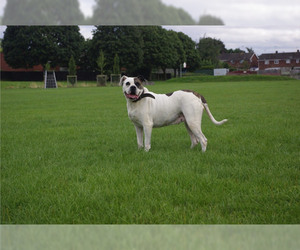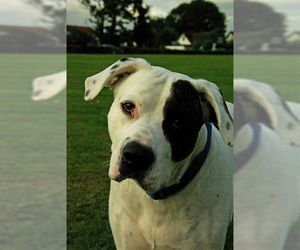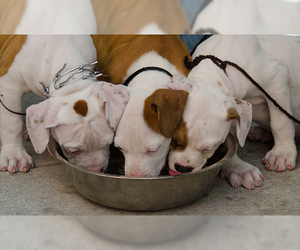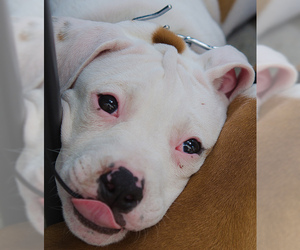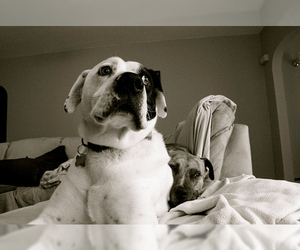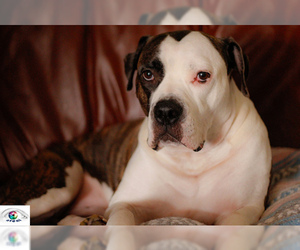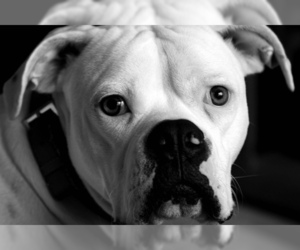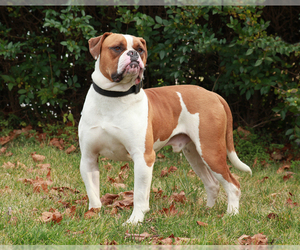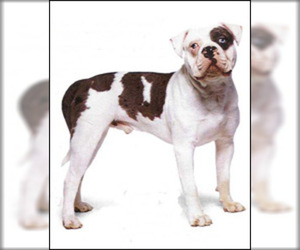
All about American Bulldog dog breed
A.K.A. :Ambull, AB, American Bully, Johnson Bulldog, Scott Bulldog, Classic Bulldog, Standard Bulldog, American Pit Bulldog, Country Bulldog, Farm Bulldog, American Guardian, Bulldogge, American Molosser, AB Companion, Muscle Bulldog, Southern Bulldog, American Tracker, AB Scout
Size
Grooming requirements
Exercise requirements
Good with other dogs
Watchdog ability
Energetic
Training requirements
Playful
Affectionate
Good with other pets
Good with children
Good with strangers
Winter
Summer
Healthiness
Protective
Life Span
| Pure Breeds | Member |
| Breeds A - Z | A |
| Breeds by Group | Flock Guards & Mastiffs Non-Sporting Working |
| Breeds by Trait | Good With Kids High Stamina Dog Breeds Low Shedding |
| Overview: | The American Bulldog, a powerful and athletic breed, boasts a fascinating lineage rooted in the working bulldogs brought to America by immigrants. These dogs were bred for various farm tasks, including herding and guarding, which contributed to their robust build and tenacious spirit. Physically, they are strong and muscular, typically weighing between 60-120 pounds, with a broad head, powerful jaws, and a short, dense coat that can come in various patterns, often with white as the predominant color. Temperamentally, American Bulldogs are known for being courageous, confident, and incredibly loyal to their families. While they possess a protective instinct, they are also affectionate and good-natured, making them excellent companions. They generally get along well with children and other pets when properly socialized, though their strength and energy require attentive supervision. Due to their active nature and need for space, American Bulldogs are best suited for homes with yards rather than small apartments. They thrive on regular exercise and mental stimulation, otherwise, they may develop destructive habits. Regarding health, while generally hardy, they can be prone to certain conditions like hip and elbow dysplasia, ichthyosis, and various allergies. Prospective owners should always seek out reputable breeders who conduct health screenings to ensure the well-being of their future furry friend. |
F.A.Q.
All You Need to Know About the American Bulldog Breed
The American Bulldog, a true American original, hails from the Southern states where it was bred for farm work. These powerful yet agile dogs are known for their confident, loyal, and affectionate temperament, making them superb family companions. Physically, they're muscular with a strong build, a short coat (requiring minimal grooming), and come in various sizes within the breed standard. They are generally good with children and other pets when properly socialized, but their size and energy mean they're better suited for homes with yards than small apartments, although they can adapt with sufficient daily exercise. Expect moderate exercise needs – a good walk or playtime will suffice. While robust, common health concerns include hip and elbow dysplasia and certain allergies. Owning an American Bulldog means bringing a devoted and protective, yet gentle, giant into your home.American Bulldog Weight: A healthy adult American Bulldog typically weighs between 60 and 120 pounds. Males are generally heavier, averaging 80-120 lbs, while females are usually 60-100 lbs. This average size makes them a powerful, athletic breed. Maintaining a healthy weight for your American Bulldog is crucial for their overall well-being.
Certainly, here's an FAQ-style answer for a classified site:What is the average height of an American Bulldog in inches?
When considering an American Bulldog's height, you're generally looking at a powerfully built dog that stands at a medium to large size. The typical adult American Bulldog average size is measured at the shoulder (withers).On average, you can expect an American Bulldog to be about 22-27 inches tall at the shoulder. However, there can be some variation:- Males: Generally stand a bit taller, typically in the range of 22-27 inches.
- Females: Are usually slightly smaller, often ranging from 20-25 inches.
The American Bulldog comes in a variety of American Bulldog colors, with white being the most prevalent, often accompanied by patches of other colors. AKC recognized American Bulldog colors (though the AKC does not fully recognize the American Bulldog breed, organizations like the ABNA and NKC accept these) include brindle, fawn, cream, and various shades of tan. These are considered standard and are often seen in show lines.Beyond the traditional, there are also rare coat types and exotic American Bulldog variations. These include blue American Bulldogs, lilac American Bulldogs, merle American Bulldogs, and chocolate American Bulldogs. These rarer colors and patterns are not accepted by major kennel clubs like the ABNA or NKC and may indicate a mixed lineage or be associated with specific breeders specializing in these unique genetics. While visually striking, potential buyers should be aware that these rare American Bulldog colors might not be considered "breed standard" and their pricing may reflect their rarity rather than their adherence to traditional breed characteristics.
The American Bulldog personality is renowned for its loyal, friendly, and confident nature. These dogs are deeply devoted to their families, often forming strong bonds. While possessing a gentle disposition that makes them excellent companions, they also exhibit a protective instinct, making them watchful guardians.The temperament of American Bulldog is generally sociable with people, though early socialization is key to ensuring they are well-adjusted. They are known for being great with children, often displaying patience and playfulness, but supervised interactions are always recommended given their size and strength. With other pets, especially other dogs, they can coexist peacefully if introduced properly and socialized from a young age. However, some American Bulldogs may have a higher prey drive, so careful introductions and supervision with smaller animals are essential.Despite their athletic build, American Bulldogs can be adaptable to apartment living if they receive sufficient daily exercise. They thrive on human companionship and can become destructive if left alone for extended periods without mental and physical stimulation. They require a confident owner who can provide consistent training and boundaries.
The American Bulldog temperament is generally described as confident, outgoing, and loyal, making them excellent family companions. They are known for being incredibly affectionate with their owners and form strong bonds. These dogs are typically very friendly and sociable with people they know, often displaying an almost childlike playfulness. While their size might be intimidating, they are often gentle giants with their loved ones.
With children, American Bulldogs are usually very good-natured, patient, and protective, often becoming devoted guardians. However, as with any large breed, supervision is always recommended during interactions. Regarding other pets, early socialization is crucial. With proper introduction and training, many American Bulldogs can coexist peacefully with other dogs and cats, though some may have a stronger prey drive, particularly towards smaller animals.They are highly intelligent but can exhibit a tendency toward stubbornness, which means consistent training with a firm, fair, and positive reinforcement approach is essential. They are also quite sensitive to their owner's emotions and respond best to a loving, structured environment rather than harsh corrections. Their desire to please their family is strong, but their independent streak can surface if boundaries aren't clear.While adaptable, the American Bulldog's energy levels and need for exercise make apartment living challenging without significant daily activity and mental stimulation. They thrive in homes with a yard where they can play and explore, and they need regular walks or jogs to burn off energy. They are not typically high-strung but require an active lifestyle to prevent boredom and destructive behaviors. Overall, the American Bulldog personality traits make them a devoted, courageous, and loving companion dog behavior for the right owner.American Bulldog Care: Daily Maintenance & Health TipsAmerican Bulldog care is relatively straightforward but requires consistent attention. This breed thrives on routine and proper management.Grooming Needs: Grooming American Bulldogs is minimal due to their short, dense coat. Weekly brushing with a rubber curry brush or mitt helps remove loose hair and stimulate natural oils, keeping their coat healthy. Occasional baths are sufficient, or as needed when dirty. Regular nail trimming (every 3-4 weeks) is crucial to prevent overgrowth and discomfort.Exercise Limitations: Despite their muscular build, American Bulldogs are a moderate-energy dog breed, not high-energy. They require at least 30-60 minutes of daily exercise, which can include brisk walks, playtime in a secure yard, or short, engaging games. Avoid strenuous exercise during hot weather, especially due to their brachycephalic anatomy. They can overheat easily.Dietary Considerations: A high-quality, protein-rich dog food appropriate for their life stage (puppy, adult, senior) is essential for American Bulldog diet. Monitor calorie intake carefully to prevent obesity, as they are prone to weight gain. Consult your veterinarian for specific dietary recommendations. Fresh water should always be available.Wrinkle and Ear Cleaning: Due to their facial folds and ear structure, wrinkle and ear cleaning are vital to prevent infections. Daily or every-other-day wiping of facial wrinkles with a damp cloth or pet-safe wipe helps prevent irritation and bacterial growth. Check and clean their ears weekly with a vet-approved ear cleaner to remove wax buildup and debris.Climate Sensitivity: American Bulldogs are sensitive to extreme temperatures because of their brachycephalic (short-nosed) anatomy. They are prone to overheating in hot, humid weather and can suffer from hypothermia in cold conditions. Always provide shade, fresh water, and avoid strenuous activity during peak heat. In winter, ensure they have a warm, sheltered place.Common Health Concerns: Key health tips for American Bulldogs include regular vet check-ups. They can be prone to skin issues such as allergies and demodectic mange, requiring prompt veterinary attention. Dental care is paramount; daily brushing or dental chews help prevent periodontal disease. Weight management is crucial to prevent joint problems and other health issues. Other potential concerns include hip and elbow dysplasia and certain eye conditions.
American Bulldog Activity Level: How active are American Bulldogs? These dogs are moderately active, blending short bursts of energy with long periods of rest. They possess a surprising athleticism for their build, enjoying engaging play sessions and moderate walks. Daily exercise needs include at least 30-60 minutes of activity, which can be broken into multiple sessions. They love interactive playtime, such as fetch or tug-of-war, and excel in activities like obedience, agility (with proper conditioning), and even dock diving. Due to their brachycephalic (short-nosed) anatomy, it's crucial to limit strenuous exercise during hot or humid weather to prevent overheating. They are not suitable for prolonged, intense endurance activities. While they enjoy being part of an active family that can provide regular engagement, their ability to relax makes them adaptable to households that appreciate a balance. They are generally not ideal for extremely low-energy households that cannot commit to their daily exercise requirements.
Because of their heavy frames, American Bulldogs are prone to hip dysplasia and elbow dysplasia, which can lead to stiffness, arthritis, and reduced mobility. Their broad chests and shorter muzzles can also contribute to Brachycephalic Obstructive Airway Syndrome (BOAS), making breathing more difficult during exercise or in hot weather. Applying brachycephalic dog care strategies—such as avoiding strenuous activity in heat, using a harness instead of a collar, and monitoring breathing—can help reduce respiratory strain.
Their loose skin and facial folds may lead to skin fold infections if not cleaned and dried regularly, while their sensitive skin makes them prone to allergies that can cause itching, ear infections, and hot spots. Their strong, compact backs may also predispose them to spinal problems, especially if they are overweight or engage in repetitive jumping.
Due to their dense musculature and shorter muzzles, American Bulldogs are also vulnerable to heat sensitivity. They thrive in moderate climates but can overheat quickly in hot or humid conditions, so they should always have access to shade, water, and cool resting areas.
Breed Breakdown: What Experts Say About the American Bulldog
I would rate the "Size" trait of the American Bulldog breed a 9 out of 10.American Bulldogs are undeniably large dogs. Males typically stand between 22-28 inches tall and weigh 70-120 pounds, while females are slightly smaller, ranging from 20-26 inches and 60-100 pounds. Their body structure is muscular and robust, giving them a substantial presence. When compared to most other companion dog breeds, such as Beagles, Shih Tzus, or even Golden Retrievers, the American Bulldog's physical dimensions are significantly greater. This breed is not well-suited for apartment living or households with significant space constraints. Their size, combined with their active nature, means they require ample room to move around comfortably both indoors and outdoors. Travel can also be challenging due to their bulk, often requiring larger vehicles and specialized crates. They thrive in homes with spacious yards and owners who can accommodate their substantial physical presence.
I would rate the American Bulldog's "Grooming Requirements" a 4 out of 10.While their short, dense coat is relatively low-maintenance, requiring only weekly brushing to remove loose hair and minimize moderate shedding, they do have a few areas that bump them up from being truly "extremely low." Their skin folds, particularly around the face and tail (if present), can accumulate dirt and moisture, necessitating regular cleaning to prevent irritation and infection. Their ears also require routine inspection and cleaning to prevent wax buildup and potential infections. Nail trimming is a standard requirement for all dogs, and American Bulldogs are no exception, needing it every few weeks. Bathing is generally only needed when they are visibly dirty, perhaps monthly or every other month, depending on their activity level. However, their susceptibility to skin issues and allergies, while not universal, is a consideration that can sometimes lead to more frequent or specialized bathing and skin care if problems arise, which can increase the overall grooming effort. Compared to many long-haired or double-coated breeds, they are quite easy to care for, but those specific areas of attention prevent them from being a "1" on the scale.
I would rate the American Bulldog's "Exercise Requirements" at a 7.While they aren't the hyperactive, constantly-on-the-go breed that a Border Collie might be, a 1 is far too low. American Bulldogs are powerful, athletic dogs bred for working roles. They possess significant energy and stamina, and thrive on a structured exercise routine. Daily walks are a necessity, but they often require more than just a leisurely stroll. Brisk walks, extended playtime in a secure yard, or engaging in activities like fetch or flirt pole are crucial for their physical and mental well-being.Their muscular build and historical use for catching and holding make them capable of sustained movement, but their brachycephalic anatomy is a significant consideration. While not as extreme as some other flat-faced breeds, they can be prone to overheating and respiratory distress in hot weather or during intense exertion. Therefore, exercise needs to be monitored and adjusted based on temperature and humidity, and they are not typically suited for extreme endurance sports or prolonged, high-intensity activities like marathons. They are intelligent and strong-willed, so mental stimulation through training, puzzle toys, and varied exercise is just as important as physical exertion to prevent boredom and destructive behaviors. While they can be calm indoors, they definitely require more than minimal activity to stay healthy and mentally stimulated, and will become restless and potentially destructive without adequate outlets for their energy.
I would rate the American Bulldog's "Watchdog Ability" as a 9.The American Bulldog is an excellent household watchdog, largely due to its inherent nature and historical purpose. They are highly alert and possess strong territorial instincts, making them keenly aware of their surroundings. Their barking behavior is typically purposeful – they don't tend to be nuisance barkers, but will emit deep, authoritative barks to signal the presence of unfamiliar sounds or people. This isn't just a casual "hello" bark; it's a warning. They are highly responsive to anything out of the ordinary, quickly shifting their attention and often taking a defensive posture. What truly elevates their watchdog ability is their willingness to deter intruders. While not inherently aggressive, their imposing size, muscular build, and confident demeanor are often enough to make an unwelcome guest think twice. If a verbal warning isn't enough, their protective instincts will kick in, making them a formidable presence. They are definitely not a passive companion in a home defense scenario; they are more than capable of providing meaningful and timely early warnings, backed by a strong willingness to protect their family and territory.
I would rate the "Good with Other Dogs" trait of the American Bulldog a 5 out of 10.While many American Bulldogs can coexist peacefully with other dogs, especially with proper socialization from a young age, they are not inherently the most dog-sociable breed. They were originally bred for tasks that required strength and a certain level of assertiveness, and this can manifest as a tendency towards dominance or a desire to be the "top dog," particularly with unfamiliar dogs or those of the same sex. Their strong prey drive, while usually not directed at other dogs within the household, can sometimes be a factor in high-energy interactions.American Bulldogs often thrive in multi-dog households where they have been introduced carefully and raised with established pack dynamics. However, they typically require careful introductions to new dogs, especially those of similar size and energy, and may not be the best choice for dog parks or off-leash areas where interactions are unstructured and with many unfamiliar canines. They can be good with dogs of different sizes, sometimes exhibiting a gentle nature with smaller, more submissive dogs, but this is not a guarantee and depends heavily on the individual dog and the other dog's temperament. They definitely require ongoing socialization and consistent training to ensure peaceful coexistence, and potential for aggression or dominance, while not universal, is a consideration that responsible owners must be prepared to manage. They aren't a breed that generally thrives by default in any canine company without careful guidance.
I'd rate the "Energetic" trait of the American Bulldog a 7 out of 10.While not hyperactive like some terrier breeds, American Bulldogs possess a substantial amount of energy that requires consistent outlets. They are naturally active and playful dogs, especially during their younger years, and thrive on physical stimulation. They have good endurance for their size and enjoy engaging in outdoor activities such as long walks, hiking, and playing fetch. Their robust build makes them well-suited for various athletic pursuits. However, compared to breeds bred for intense, prolonged running, they aren't quite at the top tier. Their brachycephalic (short-nosed) anatomy, while generally less severe than in some other bulldog types, does mean owners need to be mindful of exercise in hot weather or during periods of intense exertion, as it can affect their stamina and make them more prone to overheating. They aren't laid-back couch potatoes and will develop destructive behaviors if their energy isn't properly channeled, but they also appreciate periods of rest and can be calm indoors once adequately exercised.
I'd rate the American Bulldog's "Training Requirements" at a 7.While intelligent and capable of learning a great deal, the American Bulldog possesses a significant independent streak and a strong will, which can translate into stubbornness. Their attention span, especially as puppies, might be shorter, but they are generally focused once engaged. Responsiveness to commands can vary greatly depending on the individual dog and the trainer's consistency; they aren't inherently "eager to please" in the way some retriever breeds are. Consistency is absolutely paramount – lapses in training or boundaries will quickly be exploited. Positive reinforcement, particularly praise, play, and high-value treats, is highly effective, as harsh methods are counterproductive and can lead to resentment or resistance. They are generally not considered a beginner-friendly breed due to their strength, assertiveness, and the need for firm, consistent, and confident handling. They thrive with experienced owners who can provide a structured routine, early and extensive socialization, and ongoing training to channel their energy and intelligence effectively.
I'd rate the American Bulldog's "Playful" trait a 7 out of 10.American Bulldogs are generally very active and enjoy engaging in games and interactive play with their families. They have a strong love for toys, especially chew toys and those that encourage a good game of fetch or tug-of-war. Their attention-seeking behavior often manifests as nudging, bringing toys, or leaning against you for affection and a gentle invitation to play. While they possess a naturally spirited and enthusiastic nature, they aren't quite at the "never-stops" level of some high-energy breeds. They also have an "off switch" and are content to relax and cuddle after a good play session, making them more laid-back than, say, a Jack Russell Terrier, but still significantly more energetic and fun-loving than a Basset Hound. Their overall enthusiasm in daily life is high when it comes to activities that involve their human companions.
I would rate the American Bulldog's "Affectionate" trait a 9 out of 10.American Bulldogs are incredibly loving and people-oriented dogs who thrive on human companionship. They have a strong desire to be near their family members, often following them from room to room. While not always true "lap dogs" due to their size, they will readily lean into you, seek out physical touch, and enjoy a good cuddle session on the couch. Their loyalty is unwavering, forming deep bonds with their owners. They are also quite sensitive to owner emotions, often picking up on moods and offering comfort when needed. They are not independent in the way some breeds might be; instead, they are companion dogs who genuinely thrive on affection and being an integral part of their human family's lives.
I would rate the "Good with Other Pets" trait of the American Bulldog breed a 6 out of 10.While American Bulldogs can absolutely live harmoniously in multi-pet households, they are not inherently and universally "extremely pet-friendly" in the way some other breeds might be. Their history as working dogs, bred for tasks that sometimes involved confrontation, means they possess a moderate to high prey drive that needs careful management, especially around smaller, faster-moving animals like cats or rabbits. Early and consistent socialization from a young age is paramount for them to learn appropriate behavior around other dogs. They can also exhibit resource guarding tendencies if not properly trained and supervised, particularly with food or favorite toys. While generally not overtly aggressive, their strength and boisterous nature can be overwhelming for smaller or more timid pets if not taught to be gentle. With proper training, consistent supervision, a strong foundation in obedience, and careful introductions, they can be wonderful companions to other animals, but this typically requires a dedicated owner and is not an innate "set it and forget it" trait. They can coexist peacefully, but it often requires conscious effort and management rather than being naturally sociable from the outset with all creatures.
I would rate the American Bulldog's "Good with Children" trait a 7 out of 10.While not naturally *exceptionally* child-friendly in the way some retriever breeds are, American Bulldogs possess a strong protective instinct and, with proper socialization and training, can be wonderfully devoted and tolerant family companions. They are generally patient and surprisingly gentle with children within their own family, often viewing them as part of their "pack" to be guarded. Their playful nature can make them fun companions for older, more respectful children, enjoying games like fetch or tug-of-war. They tend to be tolerant of a certain amount of noise and typical child activity, though like any breed, excessive roughhousing or disrespectful handling could test their limits.However, their powerful build and sometimes boisterous playfulness mean they need supervision, especially with very young children, to prevent accidental bumps or knocks. They are also a strong-willed breed that benefits immensely from early socialization with children and consistent obedience training to ensure they understand their place in the family hierarchy and respond well to commands. Without this foundation, their protective instincts could manifest as over-guarding or their powerful nature could be less manageable. They are not a breed that can be left unsupervised with children and expected to inherently know how to interact perfectly. With responsible ownership, training, and early exposure, they thrive in family settings and can form deep, affectionate bonds with their human children.
The American Bulldog breed's "Good with Strangers" trait rates a 6 out of 10.While not inherently aggressive, the American Bulldog is typically more reserved and watchful around unfamiliar adults than many other breeds. They possess a natural guarding instinct, which often manifests as a cautious assessment of newcomers, sometimes accompanied by a low growl or alert bark to signal their awareness and protective nature. They are generally not the type to immediately rush up to a stranger for attention. With proper and early socialization, an American Bulldog can be trained to be polite and accepting of guests and people encountered in public. However, this comfort is more a result of positive exposure and training rather than an innate, effusive friendliness. They are adaptable in public settings if well-socialized and confident, but their default tendency is to observe and protect rather than to be overtly welcoming. They require consistent training and exposure from a young age to develop a confident and relaxed demeanor around strangers, otherwise, their natural wariness can lead to shyness or more pronounced guarding behaviors.
I would rate the American Bulldog's winter tolerance at a 3. They have a short, single coat that offers very little insulation against cold temperatures. While they are a muscular and often hefty breed, their body fat isn't enough to compensate for the lack of a protective coat. Their brachycephalic (short-nosed) anatomy can also be a disadvantage in colder weather, as it makes it harder for them to warm inhaled air, potentially leading to respiratory discomfort and a greater risk of hypothermia, especially during strenuous activity. They are prone to getting cold quickly and are not well-suited for prolonged exposure to freezing or near-freezing temperatures. Compared to many other companion dogs, American Bulldogs definitely require special care during winter months. They will need sweaters or coats for outdoor excursions, shorter walks in cold weather to prevent them from becoming too chilled, and they should never be left outside unattended in cold climates.
I would rate the American Bulldog's "Summer" tolerance as a 3.American Bulldogs, despite their generally robust appearance, are significantly susceptible to heat due to several critical factors. Their brachycephalic (short-nosed) anatomy is the primary concern. This facial structure impedes efficient cooling through panting, as they have restricted airways and often an elongated soft palate, making it difficult to effectively regulate their body temperature. This significantly elevates their risk of heatstroke, even in moderately warm conditions. Their muscular build also contributes to heat generation and retention. Consequently, their recommended outdoor activity levels in warm weather are extremely limited, primarily to early morning or late evening when temperatures are cooler, and even then, only for short durations. They absolutely require special care in summer months compared to many other companion dogs. Constant access to shade and fresh water is essential, and air-conditioned environments or other forms of climate control (like cooling mats or fans) are not just recommended but often critical during hot weather to prevent dangerous overheating. They cannot be left unsupervised outdoors in the heat for even short periods.
I would rate the American Bulldog's "Healthiness" trait as a 5 out of 10.While generally robust and athletic, the American Bulldog is prone to a significant number of breed-specific health issues that prevent it from being considered truly healthy or resilient. They are unfortunately high-maintenance in terms of potential vet visits and preventive care due to their genetic predispositions. This breed commonly suffers from various forms of hip and elbow dysplasia, which can severely impact their mobility and quality of life. Furthermore, due to their brachycephalic (short-nosed) tendencies, many individuals experience breathing difficulties, especially in warm weather or during strenuous exercise, leading to potential heatstroke and requiring careful management. Skin allergies and dermatological issues are also prevalent, often requiring ongoing treatment and dietary adjustments. Eye problems like entropion and ectropion are also seen, as are some cardiac conditions and thyroid issues. Although responsible breeding practices and preventive care, including proper nutrition and regular veterinary check-ups, can mitigate some of these risks and extend their life expectancy beyond the lower end of their typical 10-12 year range, the inherent genetic load for these conditions prevents them from ranking higher compared to more naturally robust companion dogs.
I would rate the American Bulldog's "Protective" trait at a 9 out of 10.The American Bulldog is an exceptionally protective breed. They exhibit high alertness, constantly aware of their surroundings and any changes. Their territorial instincts are strong; they are naturally inclined to defend their home and family. Loyalty to their owners is paramount, and this deep bond fuels their protective drive. While well-socialized American Bulldogs can be friendly, their initial reaction to strangers is typically cautious and often wary, especially if they perceive any threat. They are highly suitable as both watchdogs, alerting to any perceived intrusion with a powerful bark, and capable guard dogs, possessing the physical prowess and courage to deter or confront a genuine threat. This breed is not merely a companion dog; while affectionate with its family, it is definitely capable of offering meaningful, even formidable, protection in a household setting.
I would rate the "Life Span" trait of the American Bulldog at a 6.American Bulldogs typically live between 10 to 12 years, which is generally considered an average lifespan for a medium to large breed dog. While not exceptionally long-lived, they also aren't significantly short-lived compared to many other companion dogs. They are susceptible to some common health issues that can impact longevity, such as hip and elbow dysplasia, certain cancers, and eye conditions, but these are often manageable with good care and responsible breeding practices. Bloat is another concern due to their deep chests, which can be life-threatening if not addressed quickly. However, a well-bred American Bulldog from a reputable breeder, given proper nutrition, regular exercise, and preventative veterinary care, can certainly reach the higher end of their expected lifespan, and sometimes even surpass it. They are not plagued by a multitude of severe, widespread genetic predispositions that drastically shorten their lives compared to some other breeds.
American Bulldog Puppies for saleSee all puppies for sale
American Bulldog Dogs for adoptionSee all dogs for adoption
American Bulldog BreedersSee all breeders
Similar Dog Breeds for American Bulldog
Breed Mixes of American Bulldog
Quick Breed Selector 0 - not important, 1 - smallest, 10 - largest
Variants & Mistakes :Amercian Bulldog, Amercan Bulldog, Amrican Bulldog, Americna Bulldog, American Buldog, American Buldogge, American Bulldoge, American Bull Dog, American Bull-dog, Americn Bulldog, Amerikan Bulldog, America Bulldog, American Buldok, Amrican Bull Dog, Americain Bulldog, Americen Bulldog, Ameracan Bulldog, American Bulddog, Amercan Bulldoog, Americnan Bulldog, Americin Bulldog, Amreican Bulldog, Amercian Buldog, American Buldogg, American Bull Dogge, Amereican Bulldog, American Buhldog, American Buldug, Amrican Buldog, Amrican Buldogge, Amrican Bulldoge, Amercian Bull Dog, Amercian Bull-dog, Amercian Buldogge, Amercian Bulldoge, Americna Buldog, Americna Buldogge, Americna Bulldoge, Americna Bull Dog, Americna Bull-dog, America Buldog, America Buldogge, America Bulldoge, America Bull Dog, America Bull-dog, Amrican Buldok, Americain Buldog
